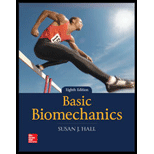
Concept explainers
a)
To determine: The torque produced at
a)
Answer to Problem 9AP
The torque created at
Explanation of Solution
Calculation:
Write an expression to find the torque at
Here,
Substitute 100 N for
Therefore, the torque created at
Therefore, the torque created at
b)
To determine: The torque produced at
b)
Answer to Problem 9AP
The torque created at
Explanation of Solution
Calculation:
Write an expression to find the torque at
Here,
Substitute 100 N for
Therefore, the torque created at
Therefore, the torque created at
c)
To determine: The torque produced at
c)
Answer to Problem 9AP
The torque created at
Explanation of Solution
Calculation:
Write an expression to find the torque at
Here,
Substitute 100 N for
Therefore, the torque created at
Therefore, the torque created at
d)
To determine: The torque produced at
d)
Answer to Problem 9AP
The torque created at
Explanation of Solution
Calculation:
Write an expression to find the torque at
Here,
Substitute 100 N for
Therefore, the torque created at
Therefore, the torque created at
e)
To determine: The torque produced at
e)
Answer to Problem 9AP
The torque created at
Explanation of Solution
Calculation:
Write an expression to find the torque at
Here,
Substitute 100 N for
Therefore, the torque created at
Therefore, the torque created at
Want to see more full solutions like this?
- Write a brief explanation of how, by calculating forces and torques in a physical system suchas the human body, it is possible to deduce the best way to lift an object without injuring yourself.Include at least one relevant mathematical formula in your presentationarrow_forwardAn isometric exercise is one in which the joint angle does not change during the application of muscle force. For instance, you can join your hands together, pushing down with one hand and pushing up with the other. In each arm, the muscles that provide the force are connected to the bones of the arm by tendons. If you increase the forces but keep the angles the same, the muscles will still contract. Explain how this is possible.arrow_forwardWhich of the following statements is correct about whathappens during flexion?a. The angle between bones is increased.b. The angle between bones is decreased.c. The bone moves away from the body.d. The bone moves toward the center of the body.arrow_forward
- A bacterial toxin is known to block the release of ACh at the motor end plate of skeletal muscle. Consequently, a. the skeletal muscle contracts with increasing force. b. the skeletal muscle contracts with increasing frequency. c. the ability to stimulate the muscle is impaired. d. other neurotransmitters would stimulate the muscle.arrow_forwardStimulation of a muscle fiber by a motor neuron occurs ata. the neuromuscular junction.b. the transverse tubules.c. the myofibril.d. the sarcoplasmic reticulum.e. none of the above.arrow_forwardIn which of the following types of exercise would creatine phosphate (CP) be an important source of energy? A. Running a half-marathon B. Biking up a mountain C. 50-meter free style swimming race D. Cross-country skiingarrow_forward
- Muscle relaxation occurs when ________. a. calcium ions are actively transported out of the sarcoplasmic reticulum b. calcium ions diffuse out of the sarcoplasmic reticulum c. calcium ions are actively transported into the sarcoplasmic reticulum d. calcium ions diffuse into the sarcoplasmic reticulumarrow_forwardWhich of the following is (are) most likely to be decreased in a person undergoing physical therapy for a sports-related muscle injury? a. 1-RM load b. Active tension c. Critical frequency d. Minimum isometric load e. Passive tension f. Tetanic tension g. Vmaxarrow_forwardWhich of these increases force production? 1. Increasing the velocity of the concentric contraction 2. Increasing the velocity of the eccentric contraction 3. Increasing strength of neural stimulation 4. Holding your breath during contraction 5. Increasing frequency of neural stimulation 6. Decreasing the velocity of the concentric contraction 7. Starting the contraction with the joint in full extension 8. Decreasing the velocity of the eccentric contractionarrow_forward
- A decline in a skeletal muscle's ability to maintain a constant level of force or tension after prolonged repetitive stimulations is called A. complete tetanus B. recruitment C. fatique D. rigor mortisarrow_forwardWhich of the following is the least movable? a. a diarthrosis b. a synostosis c. a symphysis d. a syndesmosis e. a condylar jointarrow_forwardMost of the muscles of the skeleton are attached to areas very close to the joints, so their arms, although they are very small, their mechanisms allow the movement of the human body. (a) How are they considered from the point of view of force efficiency? (b) What are the biomechanical benefits?arrow_forward
 Biology: The Dynamic Science (MindTap Course List)BiologyISBN:9781305389892Author:Peter J. Russell, Paul E. Hertz, Beverly McMillanPublisher:Cengage Learning
Biology: The Dynamic Science (MindTap Course List)BiologyISBN:9781305389892Author:Peter J. Russell, Paul E. Hertz, Beverly McMillanPublisher:Cengage Learning Human Physiology: From Cells to Systems (MindTap ...BiologyISBN:9781285866932Author:Lauralee SherwoodPublisher:Cengage Learning
Human Physiology: From Cells to Systems (MindTap ...BiologyISBN:9781285866932Author:Lauralee SherwoodPublisher:Cengage Learning



